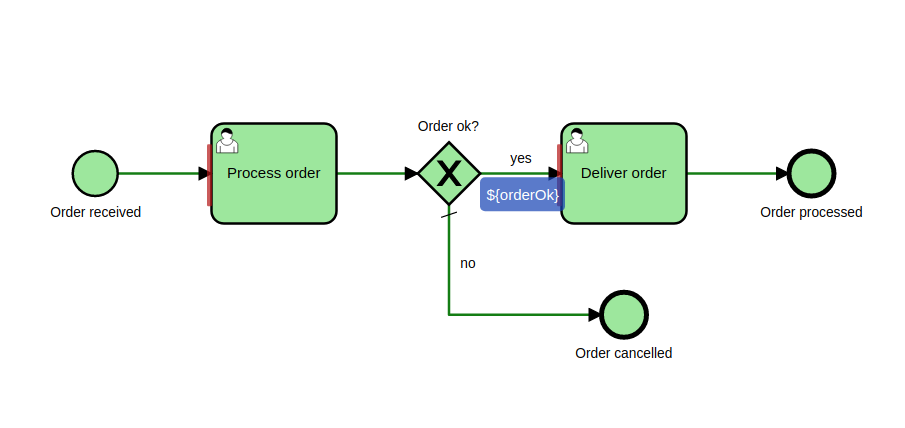This Camunda BPM community extension visualises test process paths and checks your process model coverage ratio. Running typical JUnit tests now leaves html files in your build output. Just open one and check yourself what your test did:
- Visually verify the paths covered by individual tests methods and whole test classes
- Visually check gateway expressions and transaction borders (save points) used by your process
- Calculate and verify the nodes (and sequence flow) coverage ratio reached by tests methods and classes
- Integrates with all versions of Camunda BPM starting with 7.10.0 and upwards
- Is continuously checked against the latest Camunda BPM releases (check out our compatibility CI/CD pipeline)
- Tested with JDKs 11 and 17
- Works with Java starting with 1.8 and following
- Supports JUnit 4.13.1 (4.11 does not work) or JUnit 5
- Can be used inside Spring Tests
1. Add a Maven test dependency to your project
<dependency>
<groupId>org.camunda.bpm.extension</groupId>
<artifactId>camunda-bpm-process-test-coverage-junit4</artifactId>
<version>${camunda-bpm-process-test-coverage.version}</version>
<scope>test</scope>
</dependency><dependency>
<groupId>org.camunda.bpm.extension</groupId>
<artifactId>camunda-bpm-process-test-coverage-junit5</artifactId>
<version>${camunda-bpm-process-test-coverage.version}</version>
<scope>test</scope>
</dependency><dependency>
<groupId>org.camunda.bpm.extension</groupId>
<artifactId>camunda-bpm-process-test-coverage-spring-test</artifactId>
<version>${camunda-bpm-process-test-coverage.version}</version>
<scope>test</scope>
</dependency><dependency>
<groupId>org.camunda.bpm.extension</groupId>
<artifactId>camunda-bpm-process-test-coverage-starter</artifactId>
<version>${camunda-bpm-process-test-coverage.version}</version>
<scope>test</scope>
</dependency>With the starter steps #2 and #3 are not needed anymore, as everything is auto-configured. This means you have to explicitly exclude all test classes and test methods, that should not be included in the test coverage.
You can do that, by using the following annotation on the class or method level.
@ExcludeFromProcessCoverage2. Use the ProcessCoverageInMemProcessEngineConfiguration, e.g. in your camunda.cfg.xml
<bean id="processEngineConfiguration"
class="org.camunda.bpm.extension.process_test_coverage.engine.ProcessCoverageInMemProcessEngineConfiguration">
...
</bean>Import test configuration to enable coverage in process engine.
@Import(ProcessEngineCoverageConfiguration.class)3. Wire the process engine in your JUnit test
Use the TestCoverageProcessEngineRule as your process engine JUnit rule
@Rule
@ClassRule
public static ProcessEngineRule rule = TestCoverageProcessEngineRuleBuilder.create().build();Use the ProcessEngineCoverageExtension as your process engine JUnit extension
Either use @ExtendWith
Java
@ExtendWith(ProcessEngineCoverageExtension.class)
public class MyProcessTestKotlin
@ExtendWith(ProcessEngineCoverageExtension::class)
class MyProcessTestor @RegisterExtension
If you register the extension on a non-static field, no class coverage and therefore no report will be generated. This is due to the fact, that an instance of the extension will be created per test method.
The extension provides a Builder for programmatic creation, which takes either a path to a configuration resource, a process engine configuration or if nothing is passed uses the default configuration resources path (camunda.cfg.xml).
The process engine configuration needs to be configured for test coverage. So use either the provided ProcessCoverageInMemProcessEngineConfiguration, SpringProcessWithCoverageEngineConfiguration or initialize the configuration with ProcessCoverageConfigurator.initializeProcessCoverageExtensions(configuration).
Java
@RegisterExtension
static ProcessEngineCoverageExtension extension = ProcessEngineCoverageExtension
.builder().assertClassCoverageAtLeast(0.9).build();Kotlin
companion object {
@JvmField
@RegisterExtension
var extension: ProcessEngineCoverageExtension = ProcessEngineCoverageExtension
.builder(ProcessCoverageInMemProcessEngineConfiguration())
.assertClassCoverageAtLeast(1.0).build()
}@TestExecutionListeners(value = ProcessEngineCoverageTestExecutionListener.class,
mergeMode = TestExecutionListeners.MergeMode.MERGE_WITH_DEFAULTS)You can exlude test methods from the coverage by annotating them like this
@ExcludeFromProcessCoverage
public void testWithoutCoverage() {}Running your JUnit tests now leaves html files for individual test methods as well as whole test classes in your project's target/process-test-coverage folder. Just open one, check yourself - and have fun with your process tests! 😄
4. (Optional) configure output path for reports
by default the reports are written to ./target/process-test-coverage/. To change it you can set the system property camunda-bpm-process-test-coverage.target-dir-root
<plugin>
<groupId>org.apache.maven.plugins</groupId>
<artifactId>maven-surefire-plugin</artifactId>
<version>2.22.2</version>
<configuration>
<systemPropertyVariables>
<camunda-bpm-process-test-coverage.target-dir-root>${project.build.directory}/my-coverage-reports/</camunda-bpm-process-test-coverage.target-dir-root>
</systemPropertyVariables>
</configuration>
</plugin>tasks {
withType<Test> {
systemProperties = mapOf(
"camunda-bpm-process-test-coverage.target-dir-root" to "$buildDir/my-coverage-reports/"
)
}
}There are a plenty of contributors to this project. Its initial design has been created by the WDW eLab GmbH and some others, but then the project has been abandoned for some time and received a full rewrite including the new architecture by members of flowcov.io squad and BPM craftsmen from Holisticon AG. We appreciate any help and effort you put into maintenance discussion and further development.
Please check the release notes of individual releases for the changes and involved contributors.
Apache License, Version 2.0. See LICENSE file.


